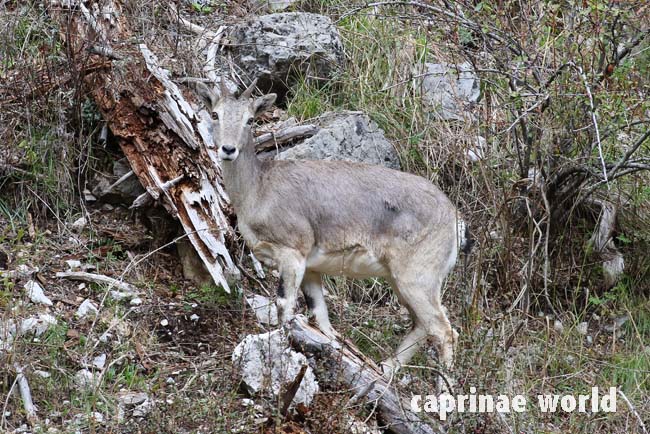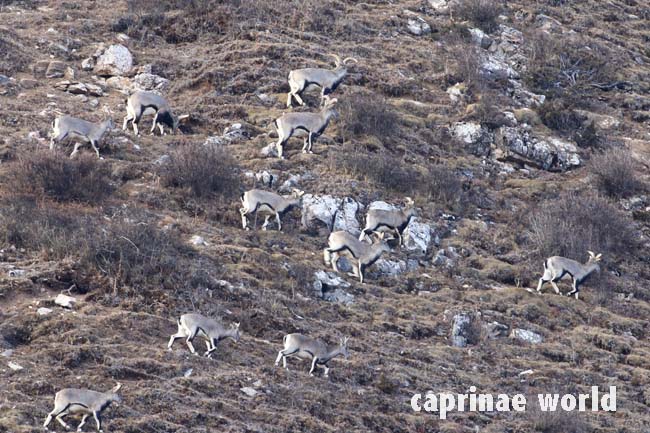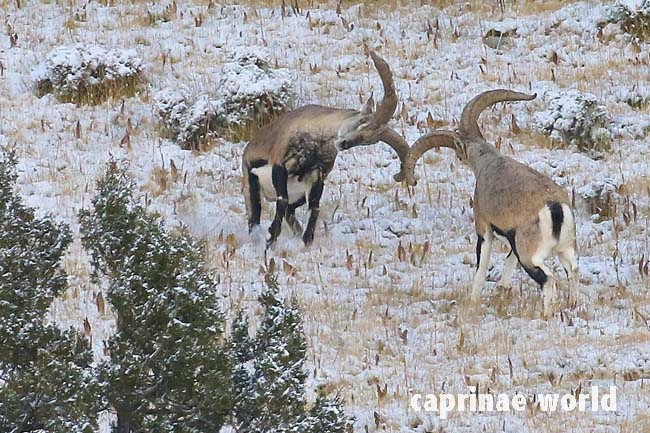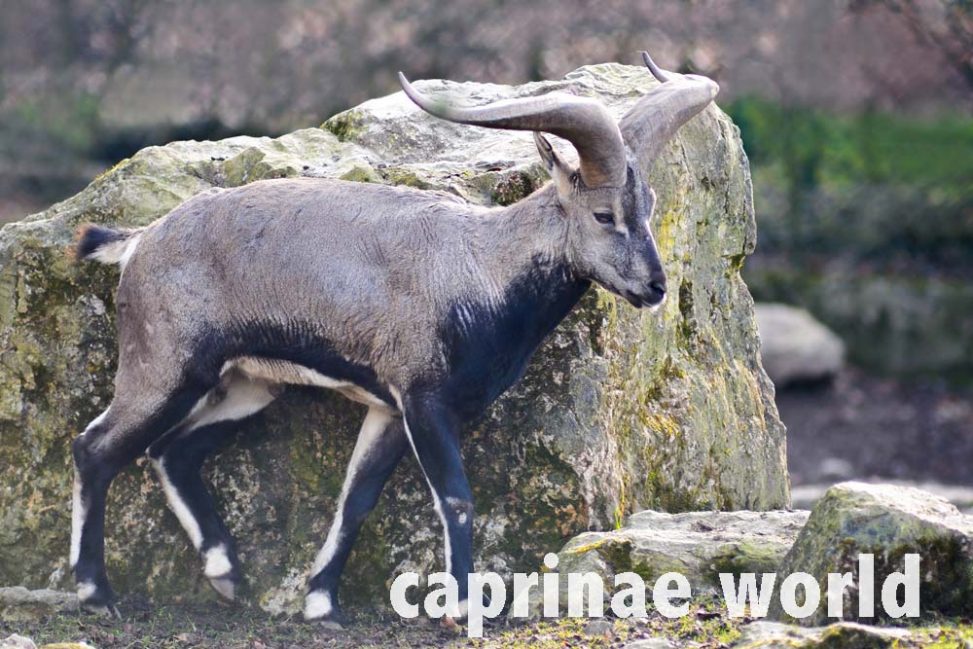Even though considered a bit smaller than the nominate race from Tibet, the Chinese Bharal with its wider flaring horns is maybe the most impressive subspecies of Bharal.

Names
Chinese: sì chuān yán yang [2]
English: Sichuan Bharal, Chinese Bharal, Chinese Blue Sheep [2]
French: Bharal du Chine, Mouflon bleu du Chine [2]
German: China-Bharal, Chinesisches Blauschaf [2]
Spanish: Baral de China, Carnero azul de China [2]
Tibetan: gong-na
Taxonomy / other (putative ) scientific names
Pseudois nayaur szechuanensis, Rothschild 1922; type locality: Shensi (Shaanxi) Province, China
Pseudois nayaur caesia, Howell 1928; type locality: Archuen, Man Shan, 230 km s of Lanzhou, Gansu Province, China
Ovis nahhour, Milne-Edwards 1869-74
Distribution
by country / provinces: China / Qinghai, Xizang, Sichuan, Gansu, Shaanxi, Yunnan, Ningxia, Neimenggu [2]
The endemic Chinese Bharal occurs in the Xizang Autonomous Region in the eastern part of the Kunlun Shan, the Altun Shan and most of Qinghai Province, the Hengduan Shan of western Sichuan Province, south as far as Yunlong in southern Yunnan Province; and in the north in the Qilian Shan and some isolated areas in the Daqinshan of Nei Mongol Autononous Region. [11] Animals from the Helan Shan on the border of Inner Mongolia’s Alxa League and Ningxia are treated at this point as Helan Shan Bharal.
The most of the western part of the Kunlun Shan in China’s Xinjiang Uyghur Autononous Region is probably mainly occupied by Tibetan Bharal (P. n. nayaur), with an undetermined towards the central [2]. Tan et al. (2017) suggest that Bharal from the westernmost spurs of the Kunlun Shan, adjacent to the Pamir Plateau, could be another subspecies. We treat animals from this area as Pamir Bharal. [13] The western range limit of Chinese Bharal on the Tibetan Plateau has not been determined satisfactorily and remains unclear with respect to the nominate subspecies. [2]
Description
general appearance: The Chinese Bharal is somewhat smaller than the Tibetan Bharal, both in body and horn size.
shoulder height: 85 cm maximum – for comparison Tibetan Bharal: 90 cm [2]
weight: 32-53 kg (n=21); maximum of 7 form Qinghai: 61 kg – for comparison Tibetan Bharal males: 54-68 kg [2]

Colouration / pelage
overall body colour in winter: slate grey back and sides [2]
overall body colour in summer: more brownish than in the Tibetan Bharal [2]

underparts: white [2]
dark pelage markings in general: less extensive than in the nominate race (Tibetan Bharal)
lateral stripe: restricted to the middle of the flanks (G. M. Allen 1930, see also Rothschild’s original type 1922); indistinct and not always present [2].

neck and brisket: the black hair here form a narrow band which starts more or less in the front centre of the neck and extends on to the legs [2]
legs: black on the front of front and hind legs, with only very small whitish markings in the „knee area“ [2] (carpals!). The inner sides are whitish. The white extends up along the posterior sides of the buttocks to the basal outer half of the tail. [2]
head: face mask more brownish than in the Tibetan Bharal [2]
tail: short, black above, fading to a dark brown towards the back (G. M. Allen 1940) [2]
Horns
Horns of mature Chinese Bharal rams are on average smaller than those of the Tibetan Bharal. Chinese Bharal have a rounded cross-section. Compared to the horn tips of the Tibetan Bharal there is a less down-ward curve, instead a sharp upward curl is typical. Because the horn tips in the Chinese Bharal are usually turned up and out the mean tip-to-tip-spread in this subspecies is wider. On the other hand they have smaller circumferences on average, tapering more quickly than those of the Tibetan Bharal. The horn surface is generally smooth, showing ridges only on the upper surface. [2]
Table 1: Horn measurements in Chinese and Tibetan Bharal [2]
| Chinese Bharal | Tibetan Bharal | |||
| length | 42-67 cm (n=78); median 57,8 cm (n=180) | median 63,5 cm (n=159) | ||
| basal circum-ference | 18-23 cm (n=78); median 25,4 cm (n=180) | median 29,2 cm (n=159) | ||
| tip-to-tip-spread | median 65,4 cm (n=15); widest 79,4, narrowest 55,6 cm | median 56,5 cm (n=30) |

Horns of females: much smaller, nearly erect (G. M. Allen 1930) [2]


Habitat
Chinese Bharal range at elevations between 3.600 and 5.000 metres and usually stay close to rock outcroppings. [2]

Threats
In the past: Starting in 1958, Chinese Bharal from Qinghai were commercially killed and about 100 to 200 tons of Bharal meat was exported to Europe yearly (Schaller 1998). Local records from Dulan, northwestern Qinghai, show that 6.641 Chinese Bharal were killed between 1981 and 1985, and ca. 64 tons of meat was purchased by the government. [2]
Currently direct mortality from poaching by non-residents is the greatest threat facing wildlife in the Yeniugou, Kunlun Shan in Haixi Mongolian People’s Autonomous Prefecture, Qinghai Province,
Trophy hunting
Prior to the hunting moratorium in China in 2006, Chinese Bharal were hunted in the Dulan International hunting grounds in northwestern Qinghai. The hunting program started in 1985 and by the end of the hunting season about 420 Chinese Bharal rams had been taken. Another hunting area, Maduo Yellow River Origin International Hunting Ground, in operation from 1997, was also located in Qinghai. Hunting fees paid by visiting hunters formed an important funding source for the Chinese State Forest Administration (SFA), although the application of funds to Chinese Bharal conservation remains in doubt. However Damm and Franco (2014) state that with well-planned harvesting strategies a hunting program could create important economic benefits for local herdsmen and their families, and also contribute funding to Bharal conservation programs. [2]
Literature cited
[1] Castelló, José R., 2016: Bovids of the World – Antelopes, Gazelles, Cattle, Goats, Sheep, and Relatives. Princeton University Press
[2] Damm, Gerhard R. and Franco, Nicolás, 2014: The CIC Caprinae Atlas of the World – CIC International Council for Game and Wildlife Conservation, Budakeszi, Hungary in cooperation with Rowland Ward Publications RSA (Pty) Ltd., Johannesburg, South Africa
[3] Dickson, Barney; Hutton, Jonathan and Adams, Bill, 2009: Recreational hunting, conservation, and rural livelyhoods – science and practice. Blackwell Publishing, Ltd
[4] Groves, Colin and Grubb, Peter, 2011: Ungulate Taxonomy. The John Hopkins University Press
[5] Grzimek, Bernhard (Hrsg.), 1988: Grzimeks Enzyklopädie, Säugetiere, Band 5. Kindler Verlag, München
[6] Harris, R. B., 2014. Pseudois nayaur. The IUCN Red List of Threatened Species 2014: e.T61513537A64313015. Downloaded on 18 June 2018.
[7] Matschei, Christian, 2012: Böcke, Takine & Moschusochsen. Filander Verlag
[8] Menon, Vivek, 2009: Field guide to Indian mammals. A&C Black Publisher Ltd., London
[9] Pfister, Otto, 2004: Birds and Mammals of Ladakh. Oxford University Press
[10] Schaller, George B., 1977: Mountain Monarchs – wild sheep and goats of the Himalaya. The University of Chicago Press
[11] Shackleton, D. M (ed.) and the IUCN/SSC Caprinae Specialist Group, 1997: Wild Sheep and Goats and their Relatives. Status Survey and Conservation Action Plan for Caprinae. IUCN, Gland, Switzerland and Cambridge, UK. 390 + vii pp
[12] Smith, Andrew T. and Xie, Yan, 2008: A guide to the mammals of China. Princeton University Press
[13] Tan, S.; Wang, Z.; Jiang, L.; Peng, R.; Zhang, T.; Peng, Q.; Zou, F., 2017: Molecular phylogeny and phylogeography of genus Pseudois (Bovidae, Cetartiodactyla): New insights into the contrasting phylogeographic structure. Ecol Evol. 2017 Jul 31; 7(17):7047-7057.
[14] Valdez, Raul, 1985: Lords of the pinnacles – wild goats of the world. Wild Sheep and Goat International, Mesila, New Mexico 88046
[15] Wilson, D. E. and Mittermeier, R. A. [eds], 2011: Handbook of the mammals of the world. Vol. 2. Hoofed mammals. Lynx Edicions, Barcelona.

